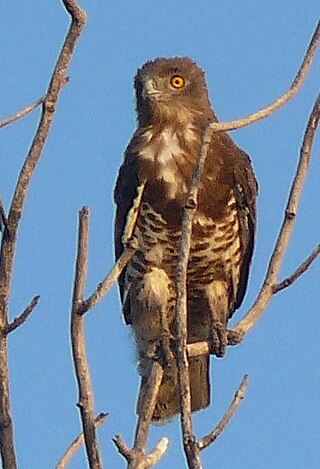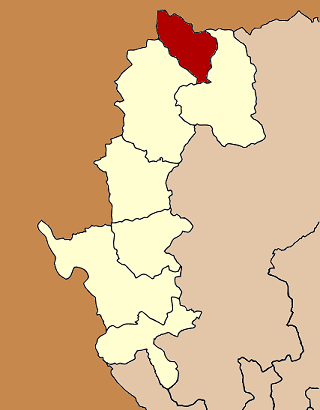
Pica is a genus of seven species of birds in the family Corvidae in both the New World and the Old. It is one of several corvid genera whose members are known as magpies.

The short-toed snake eagle, also known as the short-toed eagle, is a medium-sized bird of prey in the family Accipitridae, which also includes many other diurnal raptors such as kites, buzzards and harriers. The genus name Circaetus is from the Ancient Greek kirkos, a type of hawk, and aetos, "eagle". The specific gallicus means "of Gallia".

Moorhens—sometimes called marsh hens—are medium-sized water birds that are members of the rail family (Rallidae). Most species are placed in the genus Gallinula, Latin for "little hen." They are close relatives of coots. They are often referred to as (black) gallinules. Recently, one of the species of Gallinula was found to have enough differences to form a new genus Paragallinula with the only species being the lesser moorhen.

The Chibanian, more widely known as the Middle Pleistocene, is an age in the international geologic timescale or a stage in chronostratigraphy, being a division of the Pleistocene Epoch within the ongoing Quaternary Period. The Chibanian name was officially ratified in January 2020. It is currently estimated to span the time between 0.7741 Ma and 0.129 Ma, also expressed as 774.1–129 ka. It includes the transition in palaeoanthropology from the Lower to the Middle Paleolithic over 300 ka.

The European ground squirrel, also known as the European souslik, is a species from the squirrel family, Sciuridae. It is among the few European species in the genus Spermophilus. Like all squirrels, it is a member of the rodent order. It is to be found in eastern and central Europe from southern Ukraine, to Asia Minor, Austria, the Czech Republic, Slovakia, Serbia, Greece, Romania, Bulgaria, North Macedonia and north as far as Poland but the range is divided in two parts by the Carpathian Mountains.

Lagopus is a genus of birds in the grouse subfamily commonly known as ptarmigans. The genus contains four living species with numerous described subspecies, all living in tundra or cold upland areas.

Circaetus, the snake eagles, is a genus of medium-sized eagles in the bird of prey family Accipitridae. They are mainly resident African species, but the migratory short-toed snake eagle breeds from the Mediterranean basin into Russia, the Middle East and India, and winters in sub-Saharan Africa and east to Indonesia.

Strandzha is a mountain massif in southeastern Bulgaria and East Thrace, the European part of Turkey. It is in the southeastern part of the Balkans between the plains of Thrace to the west, the lowlands near Burgas to the north, and the Black Sea to the east. Its highest peak is Mahya Dağı in Turkey, while the highest point on Bulgarian territory is Golyamo Gradishte. The total area is approximately 10,000 km2 (3,861 sq mi).

Spirit Cave is an archaeological site in Pang Mapha district, Mae Hong Son Province, northwestern Thailand. It was occupied 12,000 to 7,000 uncalibrated radiocarbon years ago by prehistoric humans of the Hoabinhian culture.

Tetrao is a genus of birds in the grouse subfamily known as capercaillies. They are some of the largest living grouse. Feathers from the bird were used to create the characteristic hat of the bersaglieri, an Italian ace infantry formation.

The southern banded snake eagle, also known as the East African snake eagle or fasciated snake eagle, is a species of snake eagle in the family Accipitridae which is found in eastern Sub-Saharan Africa.

The Roach's mouse-tailed dormouse or ground dormouse, also known simply as the mouse-tailed dormouse, is a species of rodent in the family Gliridae. It is found in Bulgaria, European Turkey, and Greece.

Beaudouin's snake eagle is a species of snake eagle in the family Accipitridae found in the Sahel region of west Africa. It forms a superspecies with the Palearctic short-toed snake eagle Circaetus gallicus and the black-chested snake eagle Circaetus pectoralis. This bird seems to be declining in numbers and the International Union for Conservation of Nature has rated it as a "vulnerable species".

The prehistory of Southeast Europe, defined roughly as the territory of the wider Southeast Europe covers the period from the Upper Paleolithic, beginning with the presence of Homo sapiens in the area some 44,000 years ago, until the appearance of the first written records in Classical Antiquity, in Greece. First Greek language is Linear A and follows Linear B, which is a syllabic script that was used for writing in Mycenaean Greek, the earliest attested form of the Greek language. The script predates the Greek alphabet by several centuries. The oldest Mycenaean writing dates to about 1400 BC. It is descended from the older Linear A, an undeciphered earlier script used for writing the Minoan language, as is the later Cypriot syllabary, which also recorded Greek. Linear B, found mainly in the palace archives at Knossos, Kydonia, Pylos, Thebes and Mycenae, but disappeared with the fall of the Mycenean civilisation during the Late Bronze Age collapse.

Kozarnika or Peshtera Kozarnika is a cave in northwestern Bulgaria that was used as a hunters’ shelter as early as the Lower Paleolithic. It marks an older route of early human migration from Africa to Europe via the Balkans, prior to the other currently suggested route - the one across Gibraltar. The cave probably keeps the earliest evidence of human symbolic behaviour and the earliest European Gravette flint assemblages came to light here.

The Bulgarian Hound, also known as the Barak, is a hunting breed from Bulgaria. This breed is prevalent in the north, northwestern and central regions of Bulgaria. Its closest relative is the Slovak Rough-haired Pointer.

Devetàshka cave is a large karst cave around 7 km (4.3 mi) east of Letnitsa and 15 km (9.3 mi) northeast of Lovech, near the village of Devetaki on the east bank of the river Osam, in Bulgaria. The site was continuously occupied by paleo-humans for tens of thousands of years, served as a shelter for a variety of animal species during extensive periods and is now home to nearly 30,000 bats.
Tham Lod Rockshelter, first researched by Rasmi Shoocongdej from Silpakorn University, funded by the Thai Research Fund, was a prehistoric cemetery and a workshop located in Northern Thailand known to have human inhabitants from the late Pleistocene to the late Holocene period Additionally, Tham Lod is near Ban Rai, another rock shelter and is in the vicinity of two well known caves, Spirit Cave and Tham Lot cave. Recent researches and carbon dating suggested that Homo sapiens have occupied the area. These researches provide more detail on the activities by the humans in the area which includes burials, living habits, gathering, and tool making, and social interactions.
Chauvireria is an extinct genus of small-sized landfowl, belonging to the family Phasianidae, and closely related to modern partridges, Old World quails and francolins. Two species are known from the genus : C. balcanica, the type species, and C. bulgarica. Both species lived in what is today Western Bulgaria during the Early Pleistocene.
Circaetus rhodopensis is an extinct species of Circaetus that lived in Bulgaria during the Late Miocene.
















